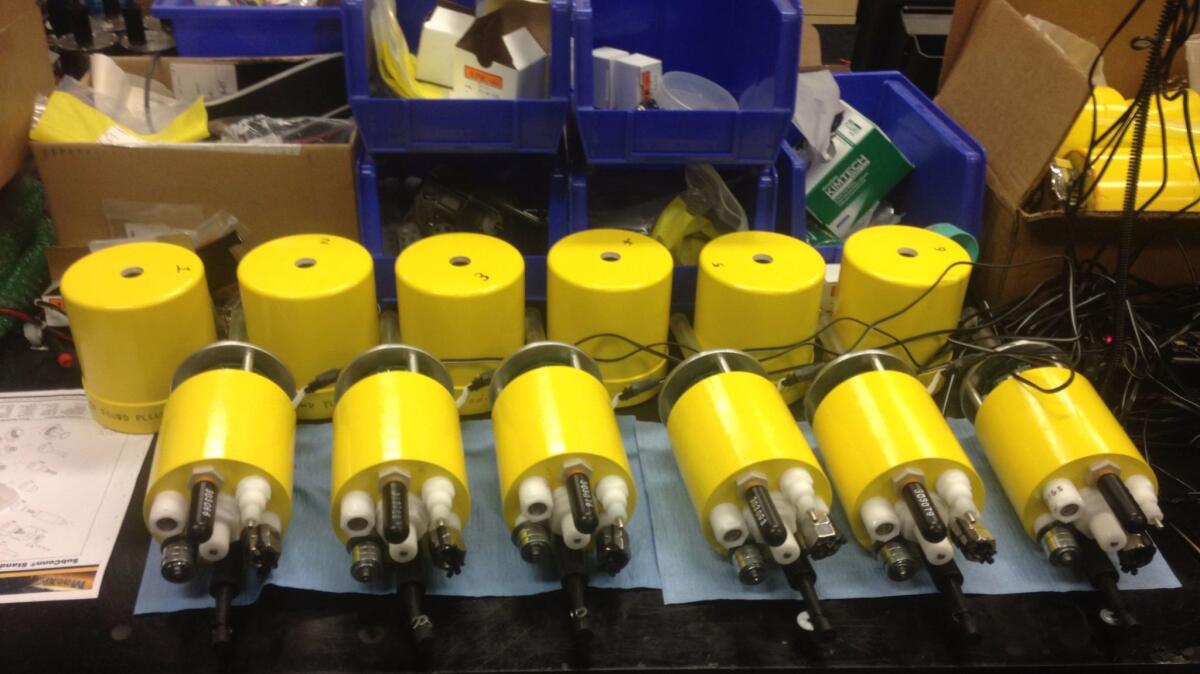Swarm of underwater robots helps scientists study ocean dynamics

A swarm of seafaring robots unleashed by researchers at UC San Diego has discovered how plankton might get together to have sex: by harnessing the motion of the ocean.
The robots, described in the journal Nature Communications, shed fresh light on the mysterious behaviors of the tiny but legion creatures that help form the foundation of marine food chains.
Scientists have long tried to study plankton, a catchall term for a diverse array of living things that reside in large bodies of water. Plankton can include bacteria, algae and even tiny animals, but these disparate groups and species share at least one characteristic: an inability to swim against a current.
As you can imagine, this has the potential to put a big crimp in a little plankter’s love life.
“If you want to find another plankter just like you so you can have sex, the equivalent in human terms would be [each] person at the far end of a football field and you both have blindfolds on and you’re just randomly walking around hoping to bump into each other,” said study coauthor Peter Franks, a biological oceanographer at UC San Diego’s Scripps Institution of Oceanography. “Obviously that’s not going to be a very efficient way to have sex.”
And yet in spite of the odds against them, plankton still manage to find each other. Take the kind of phytoplankton that cause “red tides,” enormous algal blooms that can turn the ocean murky red or brown and even kill animal life (including manatees).
So how do plankton manage to get together? Franks had an idea two decades ago after taking photos of the ocean from an airplane: Perhaps they harnessed the actual physics of the ocean. The scientist suspected that dense patches of plankton formed as they were pushed around by internal waves, which pass beneath the ocean’s surface instead of over it.
Unfortunately, trying to study whether this was true, and how exactly plankton were getting together, was easier said than done. A single sensor dropped into the ocean simply wouldn’t cut it.
“If you stick a finger in the ocean in one place, you don’t know what’s happening elsewhere,” explained lead author Jules Jaffe, an ocean engineer at Scripps.
Franks would need to take several measurements over a large area simultaneously – an idea that was proposed in the 1950s but that wasn’t possible with the technology at the time.
Jaffe, as it happens, is an expert at building devices meant to explore marine environments. Over the years, he and Franks have developed a scientific partnership of sorts.
“Jules is an absolute genius at inventing ocean instruments, and I’m always looking for new ways to look at things in the ocean,” Franks said. “So I give him scientific problems and he gives me tools to examine them ... and it’s been a wonderful collaboration over the decades.”
Jaffe’s “miniature autonomous underwater explorers,” or M-AUEs, are about the size of a large grapefruit and resemble bright yellow pool floaties. They’re equipped with temperature and other sensors and can adjust their density to sink or rise in the water, allowing them to maintain a constant depth, but that’s about as far as controlled “swimming” goes. If they move back or forth, it’s because the ocean has pushed them that way. Thus, watching how the robots move collectively allows scientists to trace the currents underwater. (The exercise also mimicked the movements of plankton, which often are able to move vertically in the water but are otherwise mostly subject to the ocean’s whims.)
After deploying 16 of these floating robots over an area that was 984 feet in diameter and tracking their movements, the researchers found that Frank’s theory had indeed been correct: The devices tended to be pushed together in the troughs of the moving waves, and spread apart over the peaks. Those troughs were helping to collect the robo-plankton into convenient little patches – just as they might do for the living organisms.
“It’s kind of like a plankton singles bar,” Jaffe said.
Now that they’ve been built and tested, these swarming sensors could be put to all kinds of uses, from monitoring oil spills and red tides to exploring the behavior of other sea creatures – for example, by listening to the calls of whales, or by tracking animals that start off as larvae on or near shores and whose complex life cycles force them to move through the ocean in ways that researchers don’t yet fully understand.
Follow @aminawrite on Twitter for more science news and “like” Los Angeles Times Science & Health on Facebook.
MORE IN SCIENCE
Addicted to Facebook? Your genes may be to blame
Did jet lag cost the Dodgers the 2016 National League pennant?




